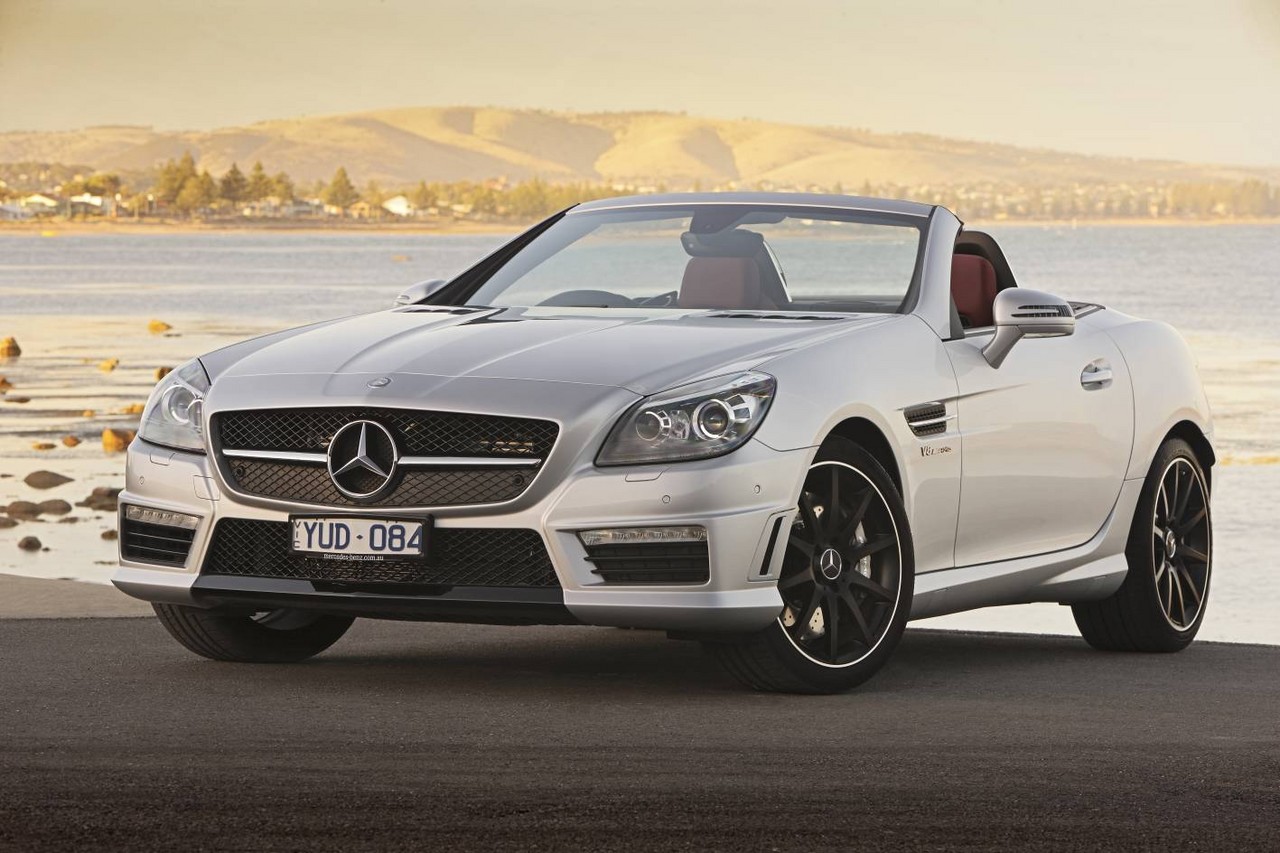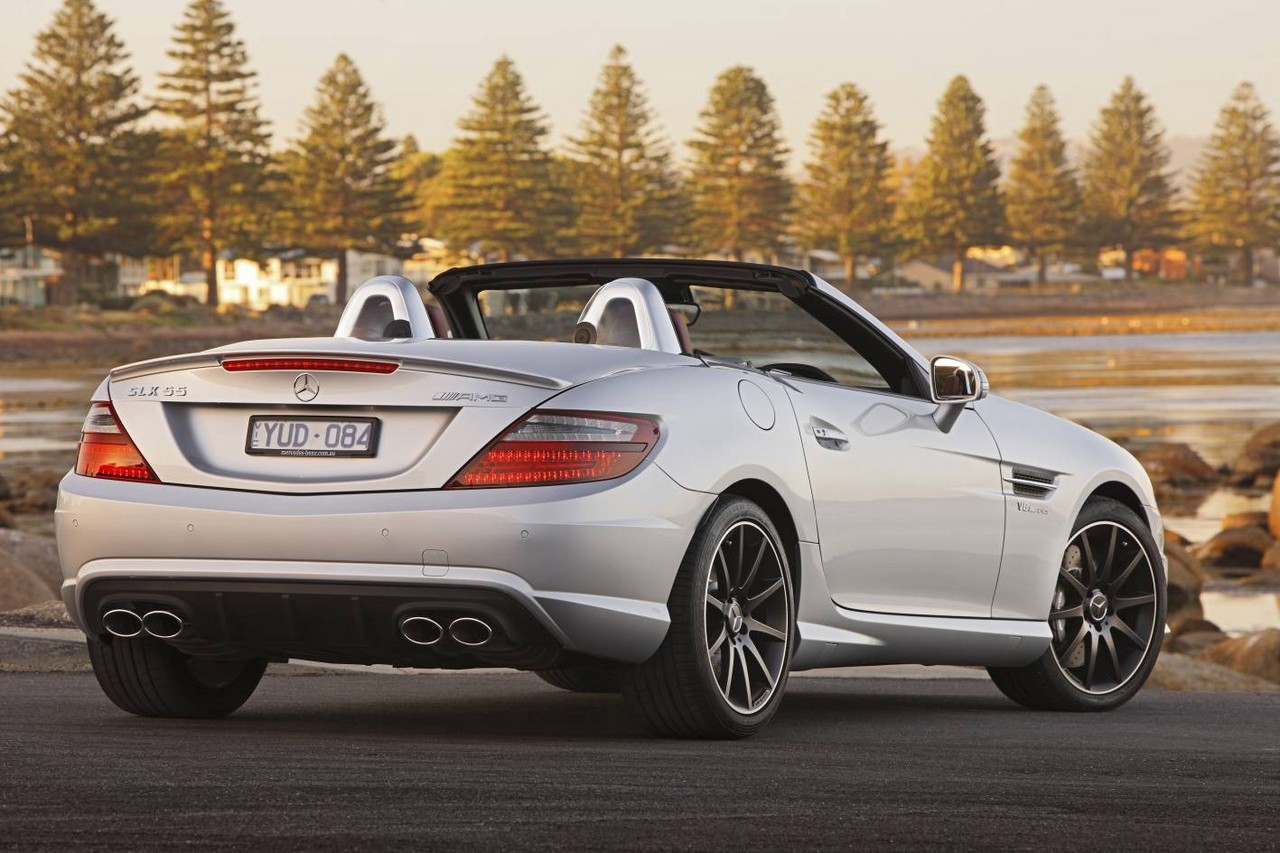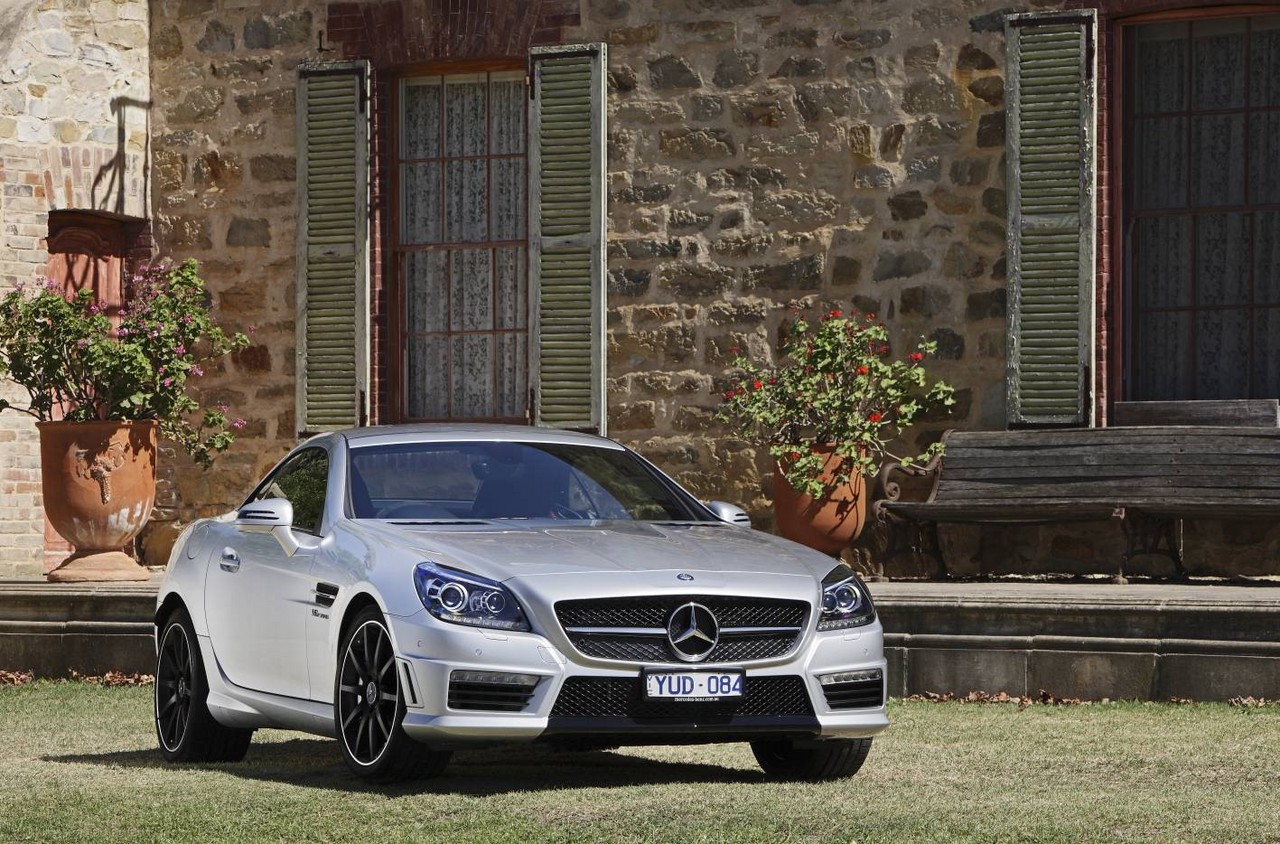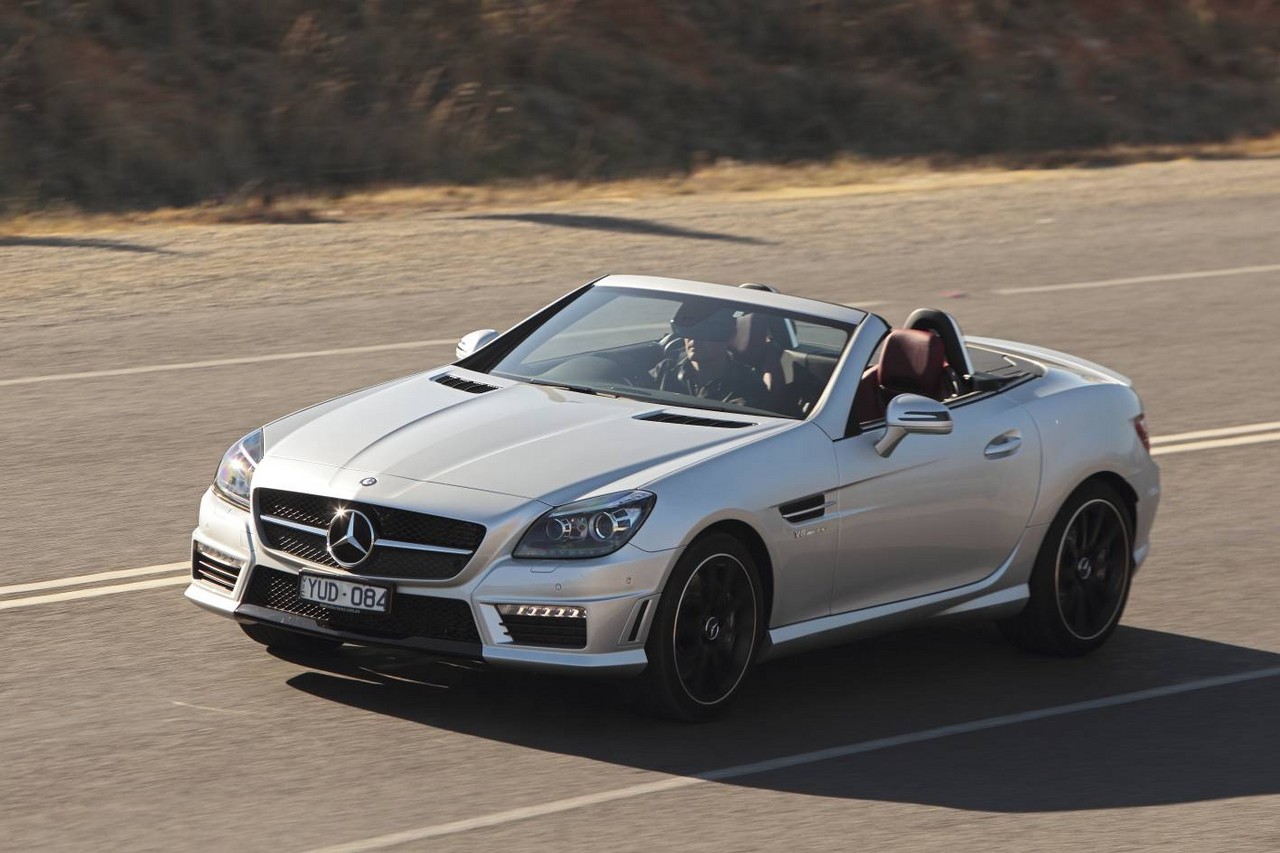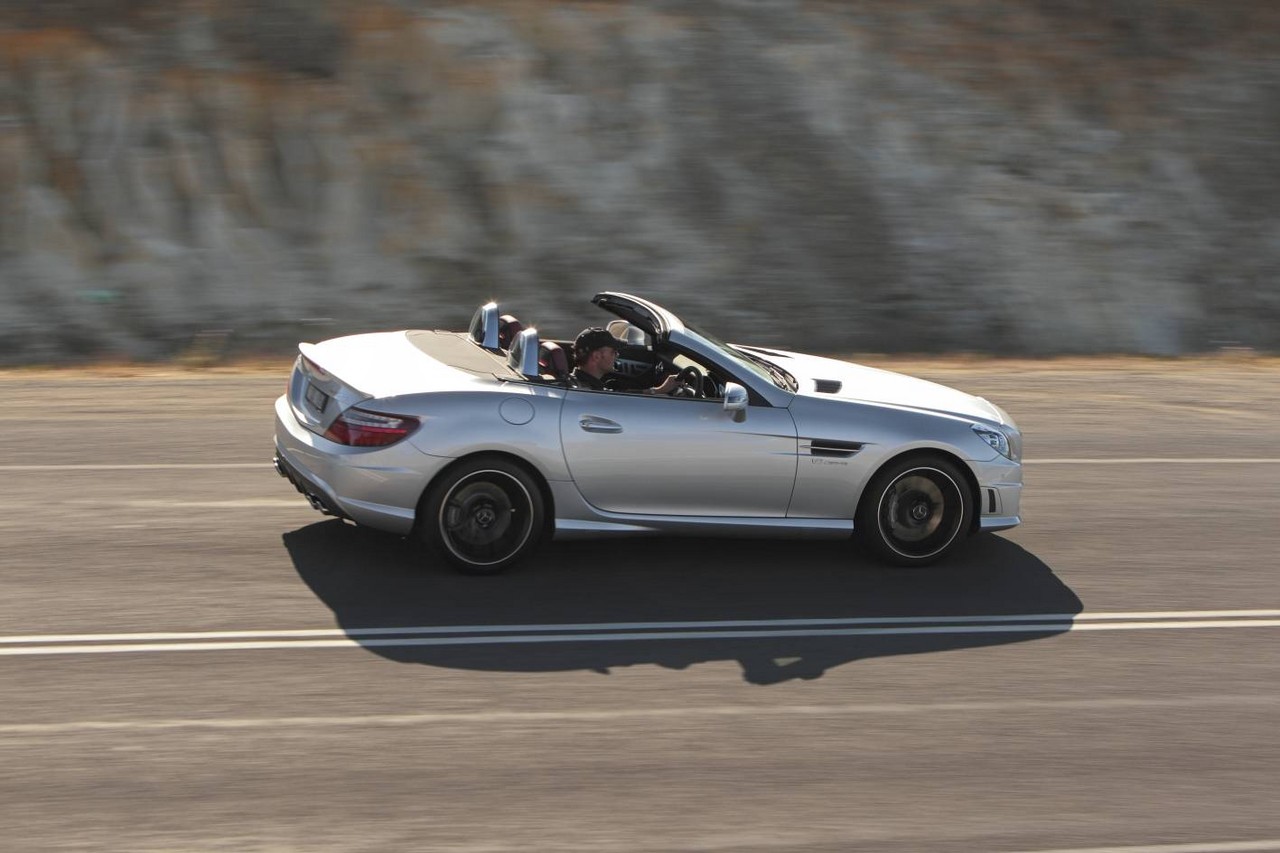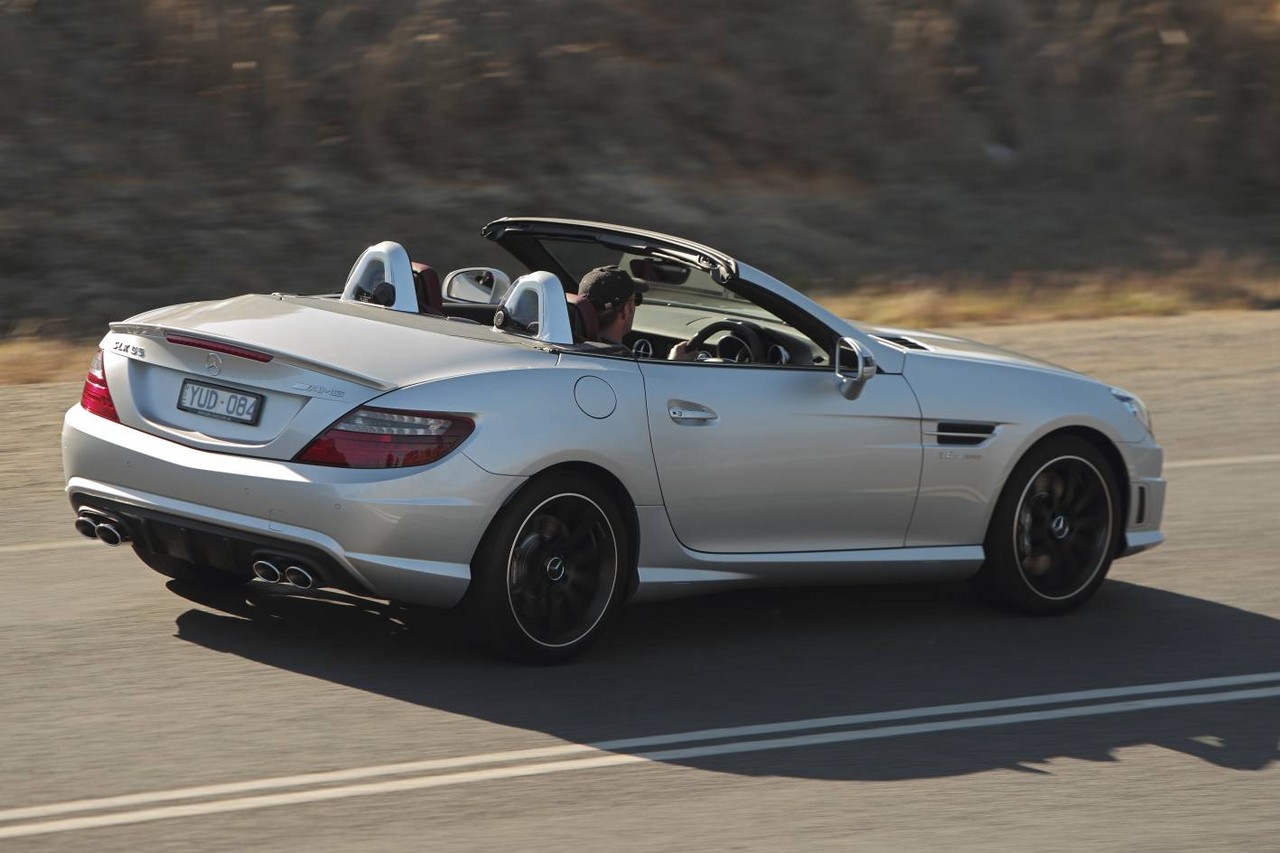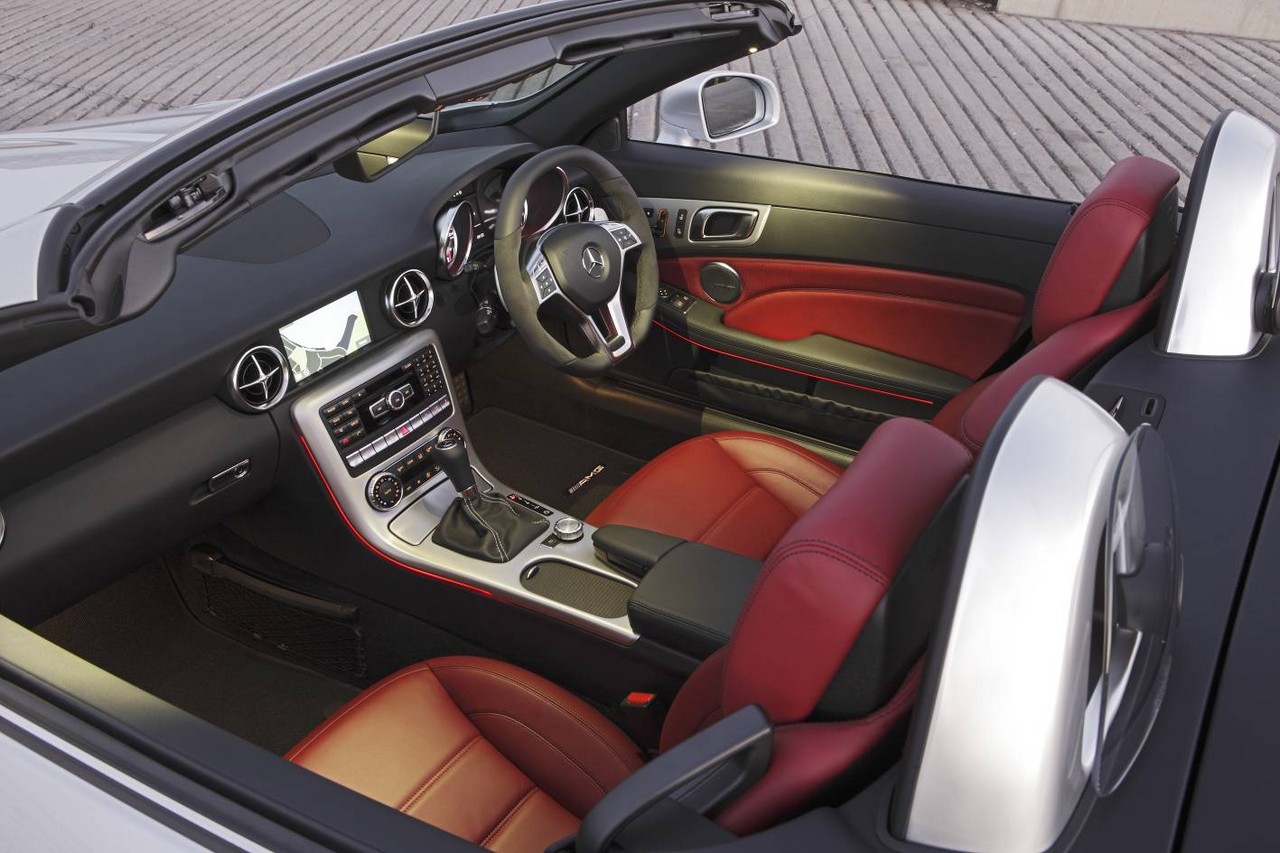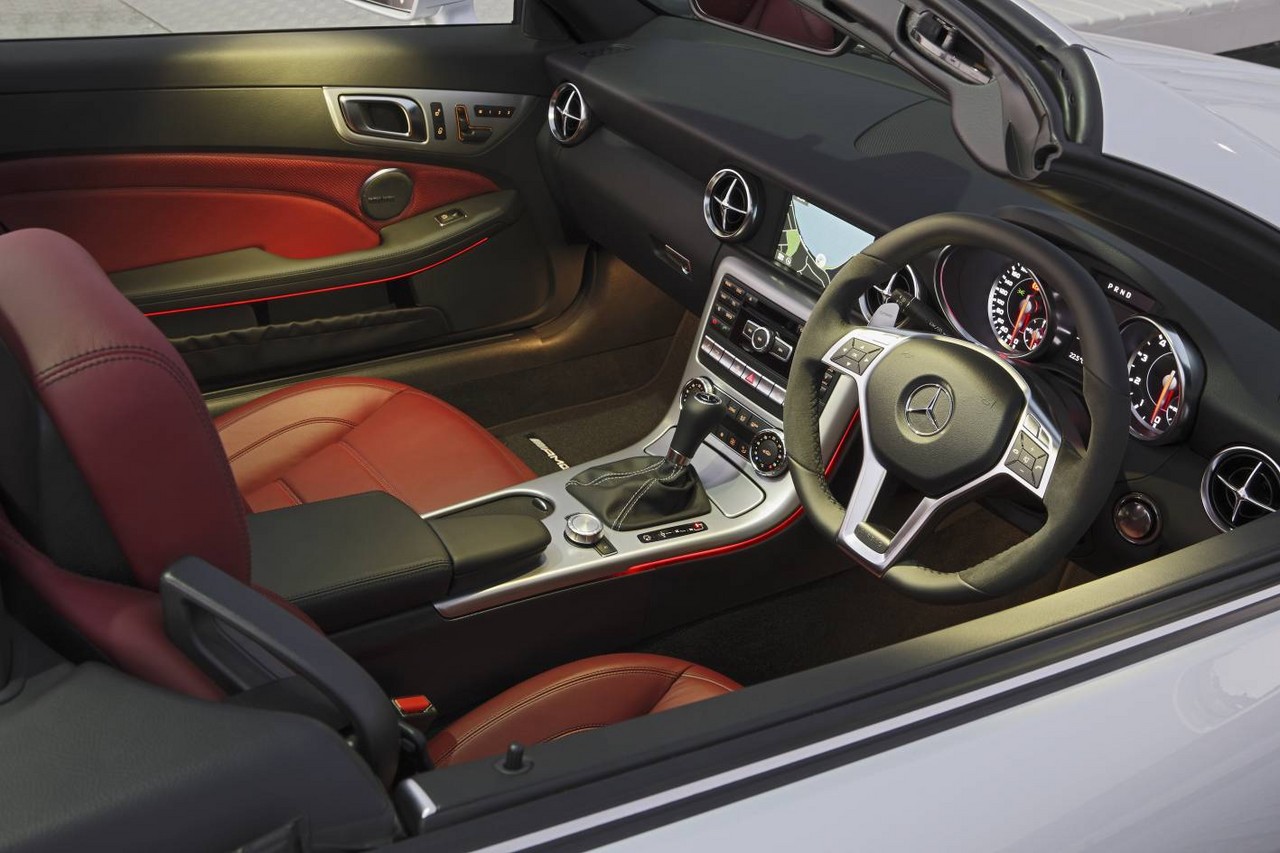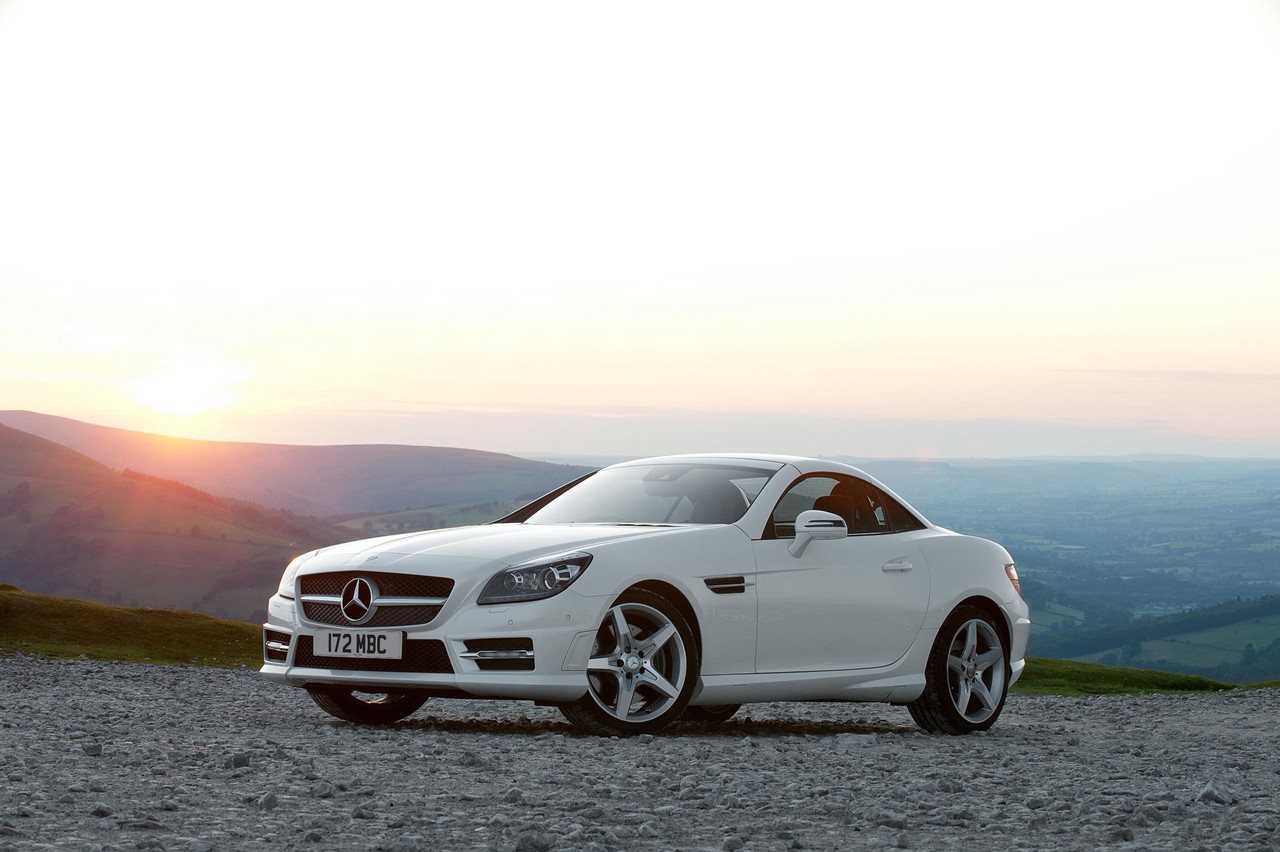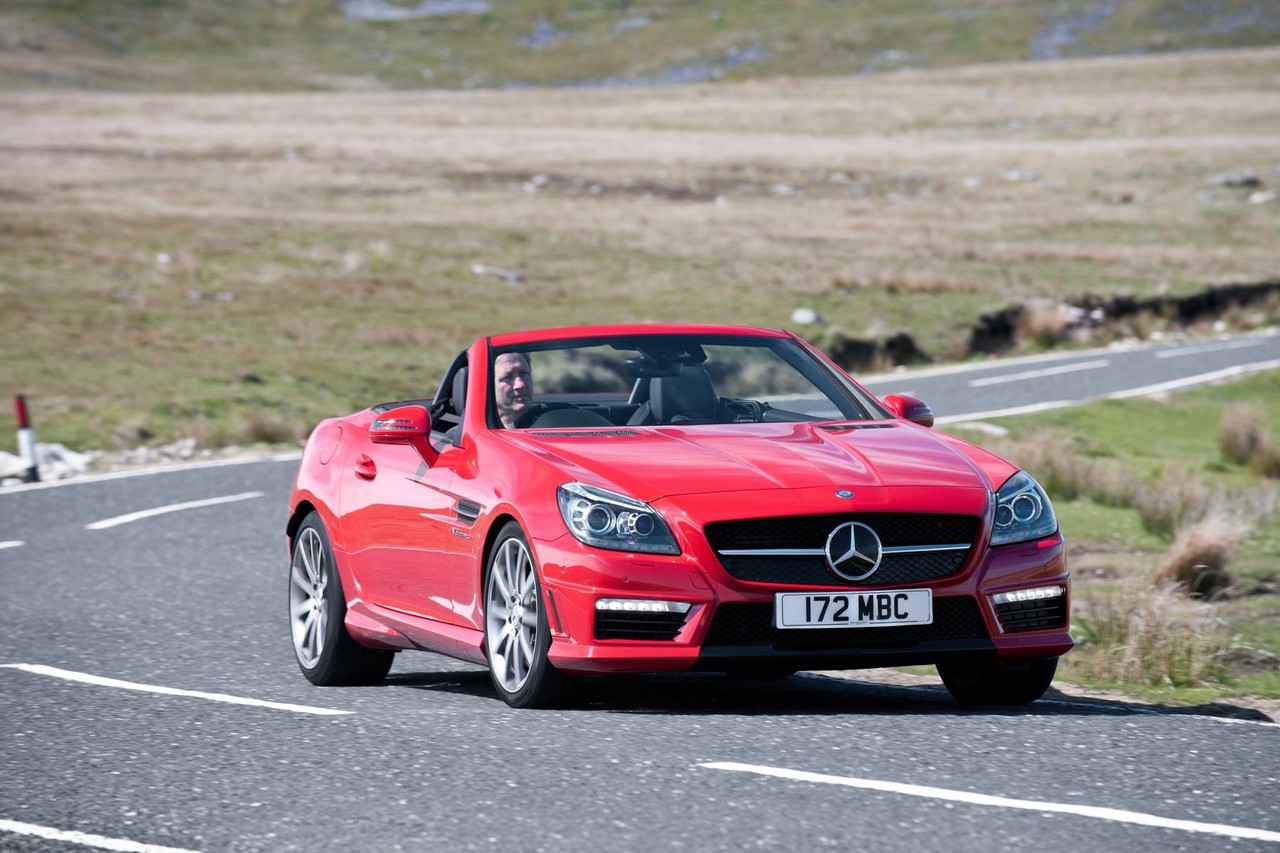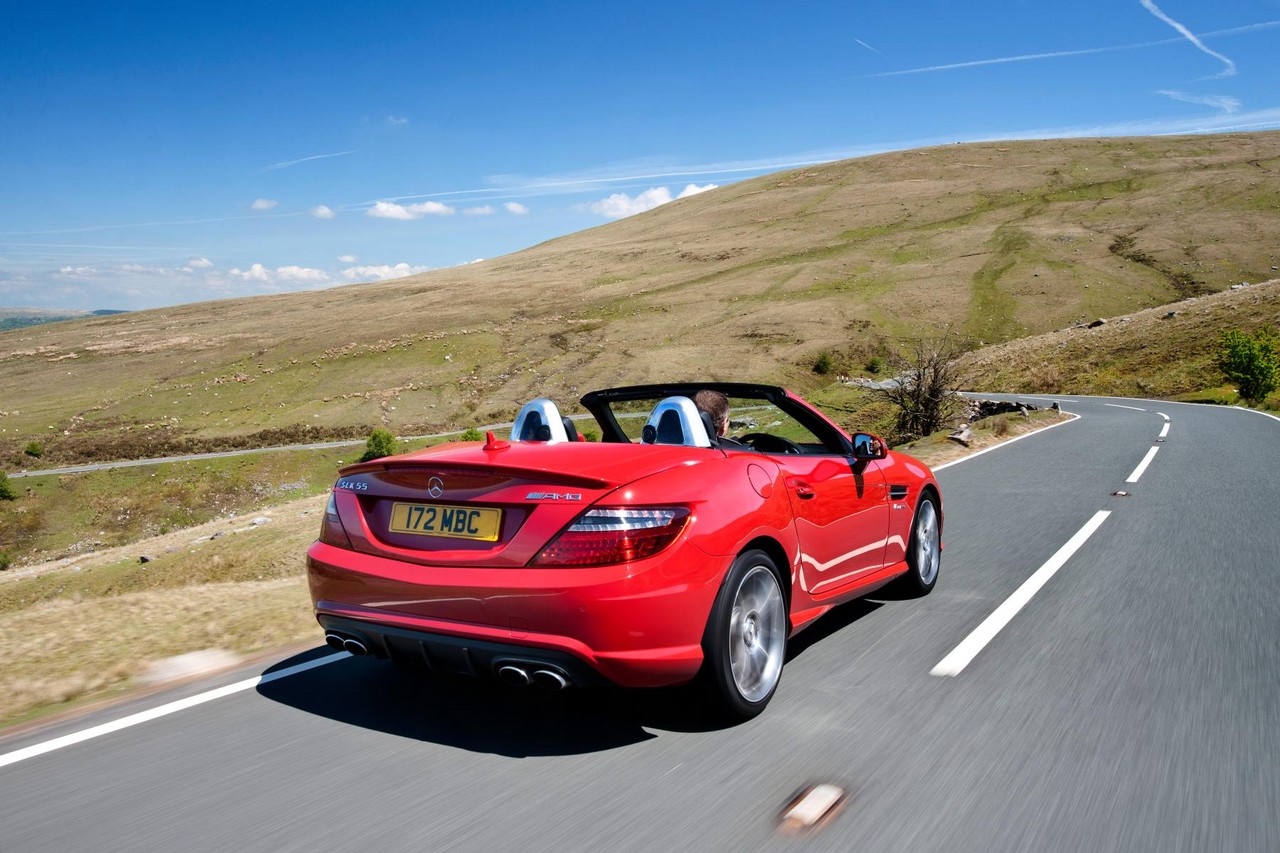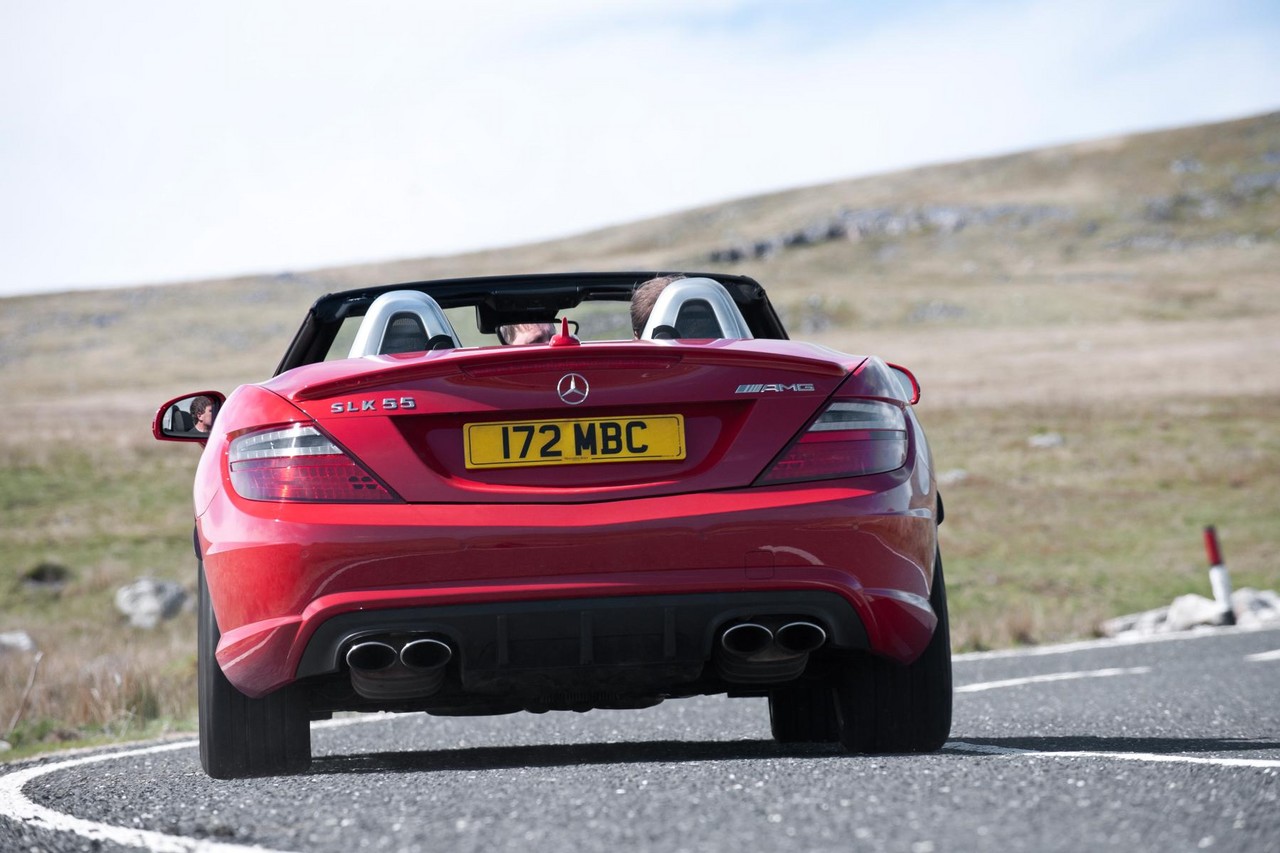
- Responsive M152 V8 engine sounds great
- Supportive front seats
- High standard of interior fit and finish
- Powerful brakes
- Suspension lacks low-speed compliance
- Nose-heavy and dynamics fall short of Porsche 981 Boxster
- Tyre noise
Overview
Released in Australia in January 2012, the Mercedes-Benz R172 SLK 55 AMG was a two-seat convertible with a power-operated hardtop roof. Manufactured in Bremen, Germany, the rear-wheel drive R172 SLK 55 AMG was powered by a 5.5-litre V8 petrol engine that was mated to a seven-speed automatic transmission.
M152 E55 V8 engine
A member of the M278 engine family, the 5461 cc M152 V8 petrol engine had a die-cast aluminium block with 98.0 mm bores and a 90.5 mm stroke, a forged 38MnS6BY steel alloy crankshaft that rotated in five main bearings and had eight counterweights, cracked and forged connecting rods, cast aluminium pistons with a special skirt coating, carbon-coated piston rings, cast-in Silitec (aluminium-silicon) cylinder liners that were treated when bolted in place (‘spectacle’ honing), spray-guided direct injection via piezo injectors at pressures of 100 to 200 bar, double overhead camshafts driven by three silent chains, variable intake and exhaust camshaft adjustment over a range of 40 degrees via four electromagnetically-controlled pivot actuators, four valves per cylinder actuated by low-friction cam followers, and a compression ratio of 12.6:1. Furthermore, the M152 engine had a maximum engine speed of 7200 rpm and dry weight of 187 kg.
Compared to the related M157 twin-turbo V8 engine, the M152 engine had new intake air ducting, new cylinder heads, a modified valve drive, an adapted oil supply system and an ‘optimised’ crankcase.
ECO Start/Stop and Cylinder Deactivation
To minimise fuel consumption, the M152 engine had:
- An ECO start/stop function that operated when the ‘Controlled Efficiency’ or ‘C’ drive mode was engaged. With ECO start/stop, the engine would shut down when the vehicle stopped in traffic and restart when the brake pedal was released or the accelerator depressed; and,
- A cylinder deactivation system which could shut down cylinders two, three, five and eight under partial loads and at engine speeds from 800 rpm to 3600 rpm; cylinder deactivation also required the driver to have engaged had selected the ‘Controlled Efficiency’ drive mode. At an engine speed of 3600 rpm, the engine could switch from four cylinder operation to eight cylinder operation in 30 milliseconds. Furthermore, the engine could produce torque of 230 Nm when operating on four cylinders.
Sports exhaust
The twin-pipe exhaust system for the SLK 55 AMG M152 engine had adjustable flaps which affected exhaust noise. At engine speeds below 2000 rpm, the exhaust flaps would remain closed so that exhaust gases would travel a longer distance and through an additional damping element.
As the vehicle accelerated, the flaps would open at angles of 15, then 30 and up to 50 degrees to progressively increase the volume of the exhaust note. Under full load at high engine speeds, both flaps would open fully.
Performance and fuel economy
The R172 SLK 55 AMG could accelerate from rest to 100 km/h in 4.6 seconds and had an electronically-limited top speed of 250 km/h. Over the combined ADR 81/02 test cycle, fuel consumption was 8.5 litres per 100 km.
| Engine | Trans. | Peak power | Peak torque | |
|---|---|---|---|---|
| SLK 55 AMG | 5.5-litre petrol V8 (M152) | 7sp auto | 310 kW at 6800 rpm | 540 Nm at 4500 rpm |
AMG Speedshift Plus 7G-Tronic transmission
The seven-speed AMG Speedshift Plus 7G-Tronic transmission enabled the driver to select from three modes:
- ‘Controlled Efficiency’, ‘C’, for smooth gearshifts, acceleration from rest in second gear (generally) and activation of the ECO start/stop and cylinder deactivation systems;
- ‘Sport’, ‘S’, which enabled sequential shifts via the steering wheel gearshift paddles, upshifted at higher engine speeds, provided faster gearshifts, activated a double declutching function when downshifting and, for faster gearshifts under full loads, enabled the engine to partially suppress ignition and injection in individual cylinders; and,
- ‘Manual’, ‘M’, for gear shifting solely via the steering wheel gearshift paddles.
The gear ratios for the seven-speed ‘AMG Speedshift Plus 7G-Tronic’ automatic transmission were 4.38 (1st), 2.86 (2nd), 1.92 (3rd), 1.37 (4th), 1.00 (5th), 0.82 (6th) and 0.73 (7th), while the final drive ratio was 2.82. Furthermore, the transmission had a double turbine torsional damper with centrifugal pendulum that adapted to engine speed to minimise vibration in four-cylinder operation.
Dimensions and body
Compared to the Mercedes R171 SLK 55 AMG , the R172 SLK 55 AMG was 59 mm longer (at 4146 mm), 23 mm wider (1817 mm) and 29 mm taller (1300 mm), though wheelbase length was unchanged (2430 mm); kerb weight, however, increased by 70 kg to 1610 kg.
The power-operated ‘vario-roof’ featured lightweight magnesium frames and could open or close in less than 20 seconds. While boot capacity was 335 litres with the roof up, this decreased to 225 litres when the roof was lowered. As standard, the SLK 55 AMG was equipped with Mercedes-Benz’s ‘Airguide’ draught stop which consisted of pivoting, transparent plastic layers that were attached to the reverse of the roll-over bars.
Relative to the standard R172 SLK-Class , the SLK 55 AMG could be identified by its darkened clear-lens headlights and darkened bi-colour tail-lights.
Suspension
The Mercedes R172 SLK 55 AMG had independent, multi-link suspension front and rear with coil springs, gas-pressure shock absorbers and stabiliser bars. Compared to the standard R172 SLK-Class, changes for the SLK 55 AMG included:
- Stiffer spring/damper tuning;
- More rigid front torque strut bearings;
- Stiffer front and rear stabiliser bars; and,
- Increased negative camber for the rear wheels.
Steering
The Mercedes R172 SLK 55 AMG had rack-and-pinion, variable ratio steering with speed-sensitive power assistance (‘AMG Direct-Steer’).
Safety equipment
Standard safety equipment for the Mercedes SLK 55 AMG included dual front airbags, front seat-mounted side airbags, front door-mounted window bags, ABS, electronic brake force distribution, brake assist, electronic stability control, traction control, driver fatigue monitoring (‘Attention Assist’), active front seat head restraints and front seatbelts with pre-tensioners and load limiters.
The SLK 55 AMG was also fitted with Mercedes-Benz’s ‘Pre-Safe’ system, which anticipated and prepared for collisions by tensioning the seatbelts and adjusting the seat positions for optimal airbag deployment. In the event of a pedestrian collision, the SLK’s bonnet would also rise to cushion the pedestrian’s subsequent impact with the bonnet (‘Active Bonnet’).
Brakes and Torque Vectoring
The Mercedes SLK 55 AMG had 360 mm by 36 mm front brake discs with fixed four-piston callipers and 330 mm by 22 mm rear discs with single-piston floating callipers; both front and rear discs were made from cast aluminium and were internally ventilated and perforated.
The SLK 55 AMG had ‘Torque Vectoring Brakes’ which worked by providing selectively applying the brakes of the inside rear wheel when cornering to produce a torque vectoring effect.
Features: Mercedes SLK 55 AMG
Standard features for the Mercedes SLK 55 AMG included 18-inch alloy wheels with 235/40 tyres, Harman Kardon Logic7 surround sound system with a six disc CD/DVD player, MP3/WMA/AAC compatibility, auxiliary (3.5mm/USB/iPod) inputs, 10GB hard drive for music storage, Bluetooth connectivity with audio streaming, Mercedes-Benz’s COMAND (Cockpit Management and Data System) Online Multimedia system, SD memory card slot, a 17.8 cm colour TFT display, HDD navigation, voice recognition (‘Linguatronic’) and internet browser, dual-zone climate control air conditioning (‘Thermotronic), neck-level heating (‘AirScarf’), AMG sports seats with power adjustment and heating, Nappa leather upholstery, cruise control with variable limiter (‘Speedtronic’), directional bi-xenon headlights, front fog lights, daytime LED running lights, automatic headlights, rain-sensing wipers, front and rear parking sensors with park guidance display (‘Parktronic’), a nappa leather-wrapped steering wheel, a multifunction steering wheel, remote central locking, power adjustable mirrors with heating and folding functions, power windows, a power adjustable steering column (for height and reach), driver memory settings (front seats, steering column and door mirrors), electrochromatic door and rear view mirrors, a power-operated park brake, 12 volt power outlet, front reading lamps, ambient lighting, tyre pressure monitoring, AMG ‘Race timer’, a motion-sensing alarm and an immobiliser.
AMG Handling Package
The extra-cost, optional AMG Handling Package included composite front brakes, AMG Performance suspension and an AMG rear axle differential lock. At launch, the AMG Handling Package was offered for $8825.
Brochures and downloads
- Press Kit: Mercedes-Benz R172 SLK-Class (August 2011)
- Specifications: Mercedes-Benz R172 SLK-Class (August 2011)
- Brochure: Mercedes-Benz R172 SLK-Class (October 2012)
- Brochure: Mercedes-Benz R172 SLK-Class (May 2014)
- Specifications: Mercedes-Benz R172 SLK-Class (March 2014)
Related links
- Press Kit: Mercedes-Benz R172 SLK (March 2011)
- Press Kit: Mercedes-Benz R172 SLK 55 AMG (November 2011)
- Wikipedia.org: Mercedes-Benz R172 SLK-Class
